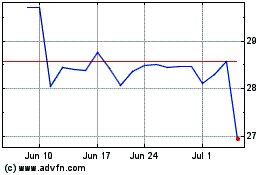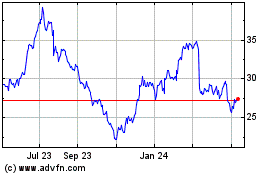By Alison Sider
The midair breakdown of a jet engine that spewed a trail of
metal over a Colorado town is putting regulatory focus on the
design and strength of engine coverings.
Four minutes into the Honolulu-bound United Airlines flight from
Denver on Saturday, pilots and passengers heard a loud bang, and
the plane's right engine began vibrating, according to the National
Transportation Safety Board's preliminary analysis of the cockpit's
voice recorder. Within 20 minutes, the plane had landed on the
runway back at Denver International Airport, with no injuries to
anyone on the ground or aboard the plane.
However, large pieces of debris plunged from the sky, landing in
yards and a soccer field. Photos and videos taken by passengers
show the airplane's right engine, stripped of its front coverings,
oscillating and in flames.
Investigators have homed in on a fan blade that had weakened
over time and broke off at its base. That fast-spinning blade
remnant appears to have sheared a second blade roughly in half. But
investigators are still trying to understand why the engine's front
external cover, known as the cowling, was then ripped away,
according to NTSB Chairman Robert Sumwalt. Something similar
happened in a handful of other engine failures caused by broken fan
blades in recent years.
"Certainly, we don't expect the cowling to separate like that,"
Mr. Sumwalt said this week, during a briefing with reporters. He
added that the safety board's investigators would examine the
engine's maintenance and inspection records.
Such damage to external engine sections isn't supposed to happen
under current manufacturing and inspection systems, which have
ushered in an era of record airline safety in the U.S. and
globally. The incident raises concerns about whether engine
coverings are too vulnerable to damage from engine components
flying forward at great speed, in addition to questions about why
the fan blades broke, some safety experts said.
Alan Diehl, a former U.S. aviation accident investigator, said
investigators and regulators will need to think about the integrity
of the structures that house aircraft engines and how they are
designed and certified. If one were to fail, that can pose a danger
to the rest of the aircraft. "They're going to have to re-examine
that," he said.
Concerns about engine coverings also came to the fore after a
Southwest Airlines flight in April, 2018, when remnants of engine
blades broke off and battered front engine coverings. When airflow
and severe vibration then broke up the damaged cover, fragments
were hurled into the wings and body of the Boeing 737. One piece
blasted out a cabin window, partially sucking out a passenger, who
died.
After that deadly Southwest engine failure, then-acting Federal
Aviation Administration chief Dan Elwell said the agency would
conduct a broad safety review focused on potential threats from
structural failures of front engine coverings. Airborne breakups of
such ancillary parts typically haven't been considered in safety
analyses or mandatory certification standards for modern jet
engines.
In responses last year to recommendations the NTSB made after
the Southwest incident, FAA Administrator Steve Dickson said the
agency was working with Boeing Co. on a design change for the type
of engine involved in the incident, and was reviewing design and
certification standards for engine casings to determine whether
broader changes were needed beyond that engine type.
The FAA is working on additional responses to the NTSB, a
spokesman said Tuesday.
The engine failure Saturday was the third in a string of
strikingly similar incidents involving the same type of Pratt &
Whitney-made engine on Boeing 777 aircraft. In all three cases, a
fan blade showing signs of fatigue largely broke off, and a second
blade was also fractured. In all three cases, damaged engine
coverings broke off.
Pratt & Whitney, a unit of Raytheon Technologies Corp.,
declined to comment Tuesday. On Sunday the engine maker said it was
working with regulators and investigators.
The FAA said it had been in the process of evaluating a Dec. 4
engine failure on a Japan Airlines flight to Tokyo when the weekend
incident happened.
A shielding ring surrounding the engine is designed to prevent
rapidly spinning internal parts from shooting through the engine's
outer casing.
Ray Valeika, a former maintenance and engineering chief at Delta
Air Lines Inc., said the prospect that a broken fan blade can shoot
forward out of the engine rather than through the sides of the
casing necessitates a new approach to how these elements are
designed and approved by regulators. It is possible, he said, that
more-efficient fan blades aren't behaving in the way that
regulators expected when the testing systems and regulations were
designed.
"We have to think differently about containment," he said. "I
think there needs to be a design review and a fault analysis review
to see if we need to change the design criteria," he said.
Engines are tested to make sure they can survive if a fan blade
breaks off. But those tests differ from conditions during flight in
key ways, according to a safety board report following a 2018
engine failure on another United flight to Hawaii, also linked to a
weakened fan blade that broke off. In that incident, fan blade
fragments spiraled forward and engine covering pieces broke
off.
During the tests, an inlet was attached to the engine, but it
wasn't made of the same material as the inlet used on the aircraft,
the NTSB report said. And coverings that surround the fan aren't
required to be on during the tests. That is a standard practice so
fan components can be observed during the tests, according to NTSB
reports.
The NTSB's report last year didn't recommend changes to the
testing procedure. The board previously had recommended that the
FAA require engine makers and aircraft manufacturers to work
together to ensure the structures that house the engines can
withstand impact from fan blades. A spokesman for the NTSB said
Tuesday that any new recommendations following from Saturday's
incident would come after an exhaustive investigative process,
expected to take 12 to 18 months, unless an urgent safety issue is
found.
Write to Alison Sider at alison.sider@wsj.com
(END) Dow Jones Newswires
February 23, 2021 18:55 ET (23:55 GMT)
Copyright (c) 2021 Dow Jones & Company, Inc.
Southwest Airlines (NYSE:LUV)
Historical Stock Chart
From Mar 2024 to Apr 2024

Southwest Airlines (NYSE:LUV)
Historical Stock Chart
From Apr 2023 to Apr 2024
